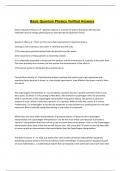Basic Quantum Physics Verified Answers
What is Quantum Physics? ✔️Quantum physics is a branch of science that deals with discrete,
indivisible units of energy called quanta as described by the Quantum Theory.
Quantum Theory ✔️There are five main ideas represented in Quantum Theory:
1.Energy is not continuous, but comes in small but discrete units.
2.The elementary particles behave both like particles and like waves.
3.The movement of these particles is inherently random.
4.It is physically impossible to know both the position and the momentum of a particle at the same time.
The more precisely one is known, the less precise the measurement of the other is.
5.The atomic world is nothing like the world we live in.
Particle/Wave Duality ✔️Particle/wave duality is perhaps the easiest way to get aquatinted with
quantum theory because it shows, in a few simple experiments, how different the atomic world is from
our world.
The Copenhagen Interpretation ✔️So sometimes a particle acts like a particle and other times it acts
like a wave. So which is it? According to Niels Bohr, who worked in Copenhagen when he presented
what is now known as the Copenhagen interpretation of quantum theory, the particle is what you
measure it to be. When it looks like a particle, it is a particle. When it looks like a wave, it is a wave.
Furthermore, it is meaningless to ascribe any properties or even existence to anything that has not been
measured. Bohr is basically saying that nothing is real unless it is observed.
While there are many other interpretations of quantum physics, all based on the Copenhagen
interpretation, the Copenhagen interpretation is by far the most widely used because it provides a
"generic" interpretation that does not try to say any more then can be proven. Even so, the Copenhagen
interpretation does have a flaw that we will discuss later. Still, since after 70 years no one has been able
to come up with an interpretation that works better then the Copenhagen interpretation.
The Wave Function ✔️In 1926, just weeks after several other physicists had published equations
describing quantum physics in terms of matrices, Erwin Schrödinger created quantum equations based
on wave mathematics , a mathematical system that corresponds to the world we know much more then
, the matrices. After the initial shock, first Schrödinger himself then others proved that the equations
were mathematically equivalent. Bohr then invited Schrödinger to Copenhagen where they found that
Schrödinger's waves were in fact nothing like real waves. For one thing, each particle that was being
described as a wave required three dimensions. Even worse, from Schrödinger's point of view, particles
still jumped from one quantum state to another; even expressed in terms of waves space was still not
continuous.
Unfortunately, even today people try to imagine the atomic world as being a bunch of classical waves.
As Schrödinger found out, this could not be further from the truth. The atomic world is nothing like our
world, no matter how much we try to pretend it is. In many ways, the success of Schrödinger's equations
has prevented people from thinking more deeply about the true nature of the atomic world.
The Collapse of the Wave Function ✔️So why bring up the wave function at all if it hampers full
appreciation of the atomic world? For one thing, the equations are much more familiar to physicists, so
Schrödinger's equations are used much more often then the others. Also, it turns out that Bohr liked the
idea and used it in his Copenhagen interpretation. Remember our experiment with electrons? Each
possible route that the electron could take, called a ghost, could be described by a wave function. As we
shall see later, the "quantum jumping" insures that there are only a finite, though large, number of
possible routes. When no one is watching, the electron take every possible route and therefore
interferes with itself. However, when the electron is observed, it is forced to choose one path. Bohr
called this the "collapse of the wave function". The probability that a certain path will be chosen when
the wave function collapses is, essentially, the square of the path's wave function .
Bohr reasoned that nature likes to keep it possibilities open, and therefore follows every possible path.
Only when observed is nature forced to choose only one path, so only then is just one path taken .
The Uncertainty Principle ✔️Newton figured that much out back in the early eighteenth century; just
observe the position and momentum of the electron as it leaves the electron gun and we can determine
exactly where it goes.
How exactly are we to determine the position and the momentum of the electron? If we disturb the
electrons just in seeing if they are there or not, how are we possibly going to determine both their
position and momentum? Still, a clever enough person, say Albert Einstein, should be able to come up
with something, right?
Unfortunately not. Einstein did actually spend a good deal of his life trying to do just that and failed.
Furthermore, it turns out that if it were possible to determine both the position and the momentum at
the same time, Quantum Physics would collapse. Because of the latter, Werner Heisenberg proposed in
1925 that it is in fact physically impossible to do so. As he stated it in what now is called the Heisenberg
Uncertainty Principle, if you determine an object's position with uncertainty x, there must be an
uncertainty in momentum, p, such that xp > h/4pi, where h is Planck's constant. In other words, you can
determine either the position or the momentum of an object as accurately as you like, but the act of
doing so makes your measurement of the other property that much less. Human beings may someday
build a device capable of transporting objects across the galaxy, but no one will ever be able to measure




